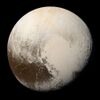Astronomy:(303775) 2005 QU182
From HandWiki
| Discovery[1] | |
|---|---|
| Discovered by | |
| Discovery date | 30 August 2005 |
| Designations | |
| 2005 QU182 | |
| Minor planet category | TNO (SDO)[2][3] |
| Orbital characteristics[4] | |
| Epoch 13 January 2016 (JD 2457400.5) | |
| Uncertainty parameter 2 | |
| Observation arc | 13642 days (37.35 yr) |
| |{{{apsis}}}|helion}} | 184.19 astronomical unit|AU (27.554 Tm) (Q) |
| |{{{apsis}}}|helion}} | 36.827 AU (5.5092 Tm) (q) |
| 110.51 AU (16.532 Tm) (a) | |
| Eccentricity | 0.66675 (e) |
| Orbital period | 1161.74 yr (424325.7 d) |
| Mean anomaly | 13.854° (M) |
| Mean motion | 0° 0m 3.054s / day (n) |
| Inclination | 14.032° (i) |
| Longitude of ascending node | 78.395° (Ω) |
| 223.69° (ω) | |
| Earth MOID | 35.8244 AU (5.35925 Tm) |
| Jupiter MOID | 31.769 AU (4.7526 Tm) |
| TJupiter | 6.711 |
| Physical characteristics | |
| Dimensions | 416±73 km[5] |
| Rotation period | 9.61 h (0.400 d) |
| Sidereal rotation period | 9.61 hr[4] |
| Geometric albedo | 0.328+0.160 −0.109[5] |
| Apparent magnitude | 20.9[6] |
| Absolute magnitude (H) | 3.80±0.32,[5] 3.6[4] |
(303775) 2005 QU182 (provisional designation 2005 QU182) is a trans-Neptunian object with a bright absolute magnitude of ca. 3.6.[4]
Distance
It came to perihelion in 1971[4] and is currently 51.8 AU from the Sun.[6] In April 2013, it moved beyond 50 AU from the Sun.
It has been observed 81 times over 10 oppositions with precovery images back to 1974.[4]

2005 QU182 takes over 1,200 years to orbit the Sun. Among large TNOs, only Sedna, 2012 VP113, 2013 FS28 and (445473) 2010 VZ98 have a longer orbit around the Sun.[7]
See also
- List of Solar System objects most distant from the Sun
References
- ↑ "MPEC 2007-R03 : 2004 PF115, 2004 PG115, 2004 XA192, 2005 QU182". IAU Minor Planet Center. 2007-09-01. http://minorplanetcenter.org/mpec/K07/K07R03.html. Retrieved 2009-08-26.
- ↑ "List Of Centaurs and Scattered-Disk Objects". Minor Planet Center. http://www.minorplanetcenter.org/iau/lists/Centaurs.html. Retrieved 2009-01-22.
- ↑ Marc W. Buie (2008-10-24). "Orbit Fit and Astrometric record for 05QU182". SwRI (Space Science Department). http://www.boulder.swri.edu/~buie/kbo/astrom/303775.html. Retrieved 2008-12-09.
- ↑ 4.0 4.1 4.2 4.3 4.4 4.5 "JPL Small-Body Database Browser: (2005 QU182)". https://ssd.jpl.nasa.gov/sbdb.cgi?sstr=2005QU182. Retrieved 7 April 2016.
- ↑ 5.0 5.1 5.2 Santos-Sanz, P.; Lellouch, E.; Fornasier, S.; Kiss, C.; Pal, A.; Müller, T. G.; Vilenius, E.; Stansberry, J. et al. (2012). ""TNOs are Cool": A survey of the trans-Neptunian region IV. Size/albedo characterization of 15 scattered disk and detached objects observed with Herschel-PACS". Astronomy & Astrophysics 541: A92. doi:10.1051/0004-6361/201118541. Bibcode: 2012A&A...541A..92S.
- ↑ 6.0 6.1 "AstDys 2005QU182 Ephemerides". Department of Mathematics, University of Pisa, Italy. https://newton.spacedys.com/astdys/index.php?pc=1.1.3.0&n=2005QU182. Retrieved 2009-03-16.
- ↑ "JPL Small-Body Database Search Engine: H < 6 (mag) and a > 80 (AU)". JPL Solar System Dynamics. http://ssd.jpl.nasa.gov/sbdb_query.cgi?obj_group=all;obj_kind=all;obj_numbered=all;OBJ_field=0;ORB_field=0;combine_mode=AND;c1_group=OBJ;c1_item=Ai;c1_op=%3C;c1_value=6;c2_group=ORB;c2_item=Bh;c2_op=%3E;c2_value=80;table_format=HTML;max_rows=200;format_option=comp;c_fields=AcBhBgBjBkBlBiBnBsCjCpCmCnCoAi;.cgifields=format_option;.cgifields=obj_kind;.cgifields=obj_group;.cgifields=obj_numbered;.cgifields=combine_mode;.cgifields=ast_orbit_class;.cgifields=table_format;.cgifields=com_orbit_class&query=1&c_sort=BhD. Retrieved 2014-06-14.
External links
 |



